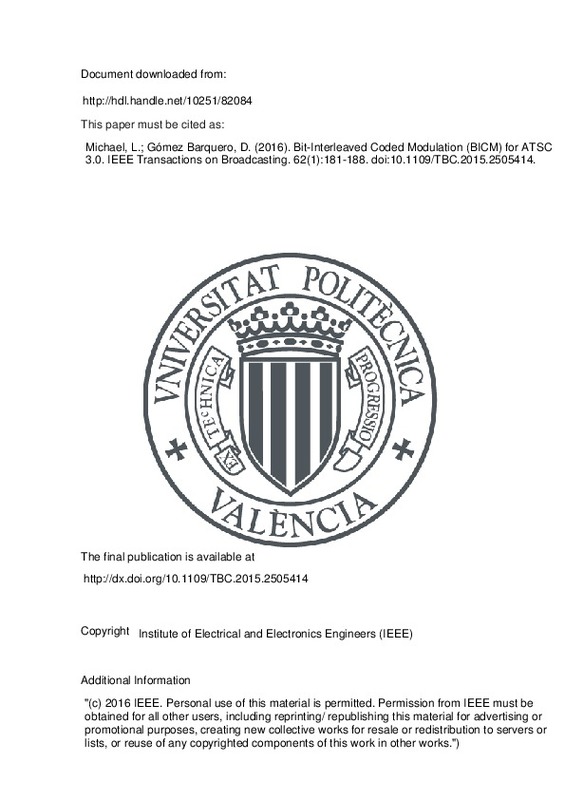JavaScript is disabled for your browser. Some features of this site may not work without it.
Buscar en RiuNet
Listar
Mi cuenta
Estadísticas
Ayuda RiuNet
Admin. UPV
Bit-Interleaved Coded Modulation (BICM) for ATSC 3.0
Mostrar el registro sencillo del ítem
Ficheros en el ítem
| dc.contributor.author | Michael, Lachlan
|
es_ES |
| dc.contributor.author | Gómez Barquero, David
|
es_ES |
| dc.date.accessioned | 2017-05-31T10:13:39Z | |
| dc.date.available | 2017-05-31T10:13:39Z | |
| dc.date.issued | 2016-03 | |
| dc.identifier.issn | 0018-9316 | |
| dc.identifier.uri | http://hdl.handle.net/10251/82084 | |
| dc.description | "(c) 2016 IEEE. Personal use of this material is permitted. Permission from IEEE must be obtained for all other users, including reprinting/ republishing this material for advertising or promotional purposes, creating new collective works for resale or redistribution to servers or lists, or reuse of any copyrighted components of this work in other works.") | es_ES |
| dc.description.abstract | In this paper, we summarize and expound upon the choices made for the bit-interleaved coded modulation (BICM) part of the next-generation terrestrial broadcast standard known as ATSC 3.0. The structure of the ATSC 3.0 BICM consists of a forward error correcting code, bit interleaver, and constellation mapper. In order to achieve high efficiency over a wide range of reception conditions and carrier-to-noise (C/N) ratio values, several notable new elements have been standardized. First, 24 original low-density parity check (LDPC) codes have been designed, with coding rates from 2/15 (0.13) up to 13/15 (0.87) for two code sizes: 16 200 bits and 64 800 bits. Two different LDPC structures have been adopted; one structure more suited to medium and high coding rates and another structure suited to very low coding rates. Second, in addition to quaternary phase shift keying, non-uniform constellations (NUCs) have been chosen for constellation sizes from 16QAM to 4096QAM to bridge the gap to the Shannon theoretical limit. Two different types of NUCs have been proposed: 1-D NUCs for 1024- and 4096-point constellations, and 2-D-NUCs for 16-, 64-, and 256-point constellations. 2-D-NUCs achieve a better performance than 1-D-NUCs but with a higher complexity since they cannot be separated into two independent I/Q components. NUCs have been optimized for each coding rate for the 64 800 bits LPDCs. The same constellations are used for 16 200 bits LDPCs, although they have been limited up to 256QAM. Finally, a bit interleaver, optimized for each NUC/coding rate combination, has been designed to maximize the performance. The result is a BICM that provides the largest operating range (more than 30 dB, with the most robust mode operating below -5 dB C/N) and the highest spectral efficiency compared to any digital terrestrial broadcast system today, outperforming the current state-of-the-art DVB-T2 standard BICM by as much as 1 dB in some cases. ATSC 3.0 will also provide a considerable increase in the maximum transmission capacity when using the high-order NUCs such as 1024QAM and 4096QAM, which will represent a major milestone for terrestrial broadcasting since the highest order constellation currently available is uniform 256QAM. This paper describes the coding, modulation, and bit interleaving modules of the BICM block of ATSC 3.0 and compares its performance with other DTT standards such as ATSC A/53 and DVB-T2. | es_ES |
| dc.language | Inglés | es_ES |
| dc.publisher | Institute of Electrical and Electronics Engineers (IEEE) | es_ES |
| dc.relation.ispartof | IEEE Transactions on Broadcasting | es_ES |
| dc.rights | Reserva de todos los derechos | es_ES |
| dc.subject | ATSC 3.0 | es_ES |
| dc.subject | Modulation | es_ES |
| dc.subject | Coding | es_ES |
| dc.subject | Spectral efficiency | es_ES |
| dc.subject | LDPC | es_ES |
| dc.subject | Non-uniform constellations | es_ES |
| dc.subject.classification | TEORIA DE LA SEÑAL Y COMUNICACIONES | es_ES |
| dc.title | Bit-Interleaved Coded Modulation (BICM) for ATSC 3.0 | es_ES |
| dc.type | Artículo | es_ES |
| dc.identifier.doi | 10.1109/TBC.2015.2505414 | |
| dc.rights.accessRights | Abierto | es_ES |
| dc.contributor.affiliation | Universitat Politècnica de València. Instituto Universitario de Telecomunicación y Aplicaciones Multimedia - Institut Universitari de Telecomunicacions i Aplicacions Multimèdia | es_ES |
| dc.description.bibliographicCitation | Michael, L.; Gómez Barquero, D. (2016). Bit-Interleaved Coded Modulation (BICM) for ATSC 3.0. IEEE Transactions on Broadcasting. 62(1):181-188. doi:10.1109/TBC.2015.2505414 | es_ES |
| dc.description.accrualMethod | S | es_ES |
| dc.relation.publisherversion | http://dx.doi.org/10.1109/TBC.2015.2505414 | es_ES |
| dc.description.upvformatpinicio | 181 | es_ES |
| dc.description.upvformatpfin | 188 | es_ES |
| dc.type.version | info:eu-repo/semantics/publishedVersion | es_ES |
| dc.description.volume | 62 | es_ES |
| dc.description.issue | 1 | es_ES |
| dc.relation.senia | 320825 | es_ES |







![[Cerrado]](/themes/UPV/images/candado.png)

